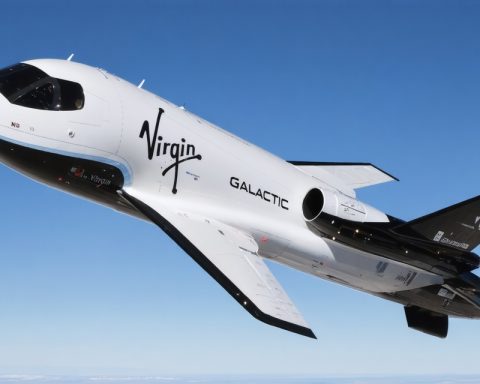- New Glenn’s upcoming launch marks a significant milestone in space exploration and aerospace technology.
- Standing at 320 feet, the rocket features a reusable first stage, capable of lifting 50 tons into low Earth orbit.
- This rocket enhances options for national security, commercial ventures, and interplanetary exploration.
- New Glenn rivals major rockets like SpaceX’s Falcon Heavy, setting new standards for orbital missions.
- The reusable technology aims for more sustainable space endeavors, though environmental concerns persist.
- Blue Origin is seeking a balance between economic viability and scientific advancement with New Glenn.
- This launch positions Blue Origin as a leader in the new era of space technology and innovation.
Blue Origin is on the brink of reimagining space exploration with its highly anticipated New Glenn rocket launch. Scheduled for liftoff from Cape Canaveral on January 10, this event heralds a transformative era in aerospace technology. Towering at 320 feet, the New Glenn boasts a groundbreaking reusable first stage, capable of hoisting a monumental 50 tons into low Earth orbit. This rocket stands as a formidable contender against giants like SpaceX’s Falcon Heavy, setting the benchmark for future orbital missions.
But why is this launch a game-changer? First, New Glenn’s versatile design opens new doors across national security, commercial sectors, and interplanetary exploration. It promises to reshape defense strategies with its formidable payload capacities, inviting commercial ventures eager for cost-efficient and dependable launch solutions. Its success could also pave the way for reaching beyond Earth’s orbit, igniting bolder space missions.
Interestingly, New Glenn’s reusable technology highlights a move towards more sustainable space ventures. While proponents celebrate the environmental benefits of reusing rocket stages, skeptics express concerns over the ecological footprint of constructing these colossal spacecraft. This duality invites a challenging question: can Blue Origin balance profitability with the spirit of scientific exploration?
Amidst the debates, one thing is clear: New Glenn’s maiden voyage is more than just a launch; it’s a beacon of what’s possible. As new frontiers in aerospace unfold, this mission positions Blue Origin at the vanguard, crafting a legacy that could lead us not just beyond Earth, but into a new age of technological marvel and innovation. The world watches as New Glenn takes flight, promising a future where the sky is no longer the limit.
Why Blue Origin’s New Glenn Rocket Launch is More Than Just a Leap into Space
Key Innovations of the New Glenn Rocket
1. What makes New Glenn’s technology so revolutionary?
The New Glenn rocket is setting new standards in space exploration with its advanced technological features. The standout element is its reusable first stage, which significantly reduces the cost per launch by allowing multiple flights with a single rocket. This is a leap forward from the traditional disposable stages. Blue Origin’s decision to capitalize on reusability ushers in an era of more sustainable and cost-efficient space missions. Additionally, the New Glenn’s payload capacity of 50 tons represents a considerable enhancement, surpassing many current rockets in its class. This technological leap positions it as a viable option for a wide array of missions, from commercial satellite deployments to ambitious interplanetary adventures.
2. How does the New Glenn compare to SpaceX’s Falcon Heavy in terms of features and market potential?
When comparing New Glenn to SpaceX’s Falcon Heavy, both rockets offer impressive payload capabilities, with the Falcon Heavy also boasting a reusable first stage. However, New Glenn’s novel design includes features like a larger payload fairing, which is crucial for accommodating larger satellites and modular payloads, offering potentially greater market versatility. In terms of market potential, New Glenn’s competitive edge lies in its focus on integration with national security missions and commercial services due to its impressive payload capacity. This, together with Blue Origin’s emphasis on innovation and sustainable practices, positions it as a strong competitor against SpaceX for both government contracts and private-sector projects.
3. What are the potential environmental impacts and sustainability considerations for New Glenn?
The move towards reusability in rocket technology, as exemplified by New Glenn, contributes significantly to reducing the ecological footprint of space launches. Nonetheless, constructing these massive rockets still involves substantial resource utilization and emissions. Critics point out that while reuse cuts operational environmental costs, the manufacturing and assembly process must also evolve to ensure overall sustainability. Blue Origin is aware of these challenges and aims to develop and adopt greener technologies and practices across its operations, from material sourcing to manufacturing processes.
The Future of Blue Origin and Space Exploration
New Glenn’s upcoming launch holds implications extending far beyond mere technical triumphs. Blue Origin is positioning itself as a major player not just in space exploration, but in shaping the future of how humanity interacts with space. Its success could redefine defense strategies, commercial opportunities, and interplanetary exploration potential.
For additional insights into Blue Origin’s vision and projects, explore their website: Blue Origin.
















